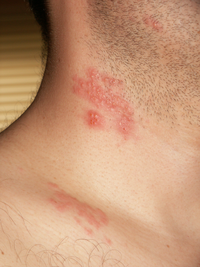
Photo from wikipedia
Purpose: The purpose of this study was to detect the occurrence of herpes simplex virus (HSV) types 1 and 2 and varicella zoster virus (VZV) DNA in transplanted corneas using… Click to show full abstract
Purpose: The purpose of this study was to detect the occurrence of herpes simplex virus (HSV) types 1 and 2 and varicella zoster virus (VZV) DNA in transplanted corneas using polymerase chain reaction (PCR) and to determine the relationship between latent HSV and VZV and herpetic eye disease in recipients. Methods: This was a retrospective, interventional case series. Samples from 88 donor corneoscleral buttons (CSBs) were collected from the conjunctiva, iris, and endothelium and tested for HSV-1, HSV-2, and VZV DNA using PCR. All transplanted eyes were evaluated and followed up. The main outcome measures were HSV-1, HSV-2, and VZV DNA positivity rates in donor CSBs and the occurrence of herpetic eye disease or graft failure in recipients of positive corneas. Results: HSV-1 DNA was detected in 5 (5.7%) of 88 CSBs. HSV-2 was not detected in any CSBs, and VZV was found in 1 (1.2%) of the 82 examined CSBs. One recipient (16.7%) developed dendritic epitheliopathy and keratouveitis typical of HSV 12 months after transplantation, although the graft remained clear after treatment. One cornea was used for a tectonic graft and stayed edematous at the 20-month follow-up. The remaining corneas remained clear. Conclusions: Morphologically normal donor corneas may be PCR-positive for herpes viruses, especially HSV-1. Recipients of herpes-positive corneal grafts could be at risk for herpetic eye disease. Further studies using viral RNA by reverse transcriptase PCR are needed to provide more information on HSV and VZV latency and active replication in donor corneas.
Journal Title: Cornea
Year Published: 2022
Link to full text (if available)
Share on Social Media: Sign Up to like & get
recommendations!